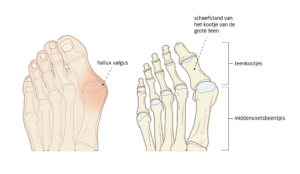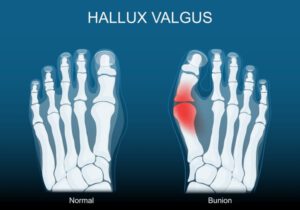I’ve recently been diagnosed with a Hallux Valgus. It developed gradually over time. It took a while to fully form. At first, it’s not very noticeable—some callus builds up, which obscures the visibility of the condition. Eventually, the foot starts to hurt a bit, especially after physical activity, for example. And then, at some point, it’s just there.
At a certain point, it’s there: the Hallux Valgus.
A Hallux Valgus is a common foot condition in which the big toe starts to lean sideways toward the other toes. This can not only cause pain, but some people also find it cosmetically bothersome.
Approximately one in three adults is affected by Hallux Valgus to some degree. Women are more frequently affected than men.

Manchester scale – classification into 5 categories

How do you recognize a Hallux Valgus?
With a Hallux Valgus, the bone just before the big toe (the first metatarsal) shifts outward, while the toe itself points inward. This results in a visible bump on the side of the foot — commonly known as a bunion.
Causes: How Does a Hallux Valgus Develop?
The exact cause is not always clear, but several factors are known to increase the risk:
- Congenital abnormalities in the foot
- Joint hypermobility
- Excessive inward rolling of the foot (overpronation)
- Tight or narrow shoes, especially high heels
The condition also tends to run in certain families. People with rheumatic conditions, such as rheumatoid arthritis, are also at increased risk.
Complaints and symptoms of a Hallux Valgus
The most common complaints include:
- Pain or difficulty while walking
- Pain on the side of the big toe
- A visible and often painful bump
- Redness or swelling at the bunion
- Trouble finding shoes that fit properly
- Worsening of pain when wearing narrow or high-heeled shoes
Other symptoms
- Sharp pain, sometimes intense, in the big toe, especially while walking or wearing certain shoes
- Bump on the inside of the foot, near the big toe
- The skin around the big toe may become swollen and red
- Callus formation: Irritated areas can develop calluses
- Stiffness: The big toe joint may become less flexible
In short. A Hallux Valgus can cause sharp pain in the big toe joint, especially when walking or wearing tight shoes. The misalignment of the toe, along with the associated bump, can cause irritation and inflammation, which may lead to pain.
How Is the diagnosis made?
A doctor or physical therapist will ask about your symptoms and how they developed. In advanced cases, the diagnosis is usually visually evident: the big toe points inward and the bunion is clearly visible.
Treatment and Recovery
In most cases, conservative treatment is chosen, such as:
- Wider shoes with low or no heels
- Foot exercises to maintain mobility
- Orthotics or a night splint to help correct the alignment
- Surgery: In some cases, surgery may be necessary to correct the toe’s position
- Consult a specialist, for severe complaints, it is advisable to seek advice from a podiatrist, physiotherapist, or orthopedic surgeon.
In conclusion
For persistent or severe complaints, surgery may be required. The surgeon will then restore the toe’s alignment. In more severe cases, the toe joint may be fused. These procedures generally yield good results.
More information about this condition can be found on this website. If you’d like to contact me, you can do so via the contact form on this site.






